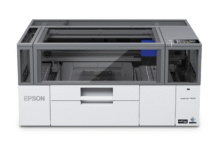At its recent media launch of the Konica Minolta Accurio C7100 and C7090, the global company shared a considerable amount of market data on digital print engines in India. Salient points included the increase in KM’s share in monochrome printing, where it is now as dominant as it is in the light-color and mid-color segments.
The rise in digitally produced monochrome pages was visible even before the pandemic, with the import of new digital monochrome engines accelerating. This was partly attributed to the better absorption of monochrome digital presses by book printers.
Additionally, Konica-Minolta India’s overall market share improved in both the pandemic-dominated calendar years of 2020 and 2021 – even as the digital press market took a hit of 41% and 26%, respectively in each of those years, in comparison to digital press sales in 2019.
The KM Accurio C7100 and C7090 replace the C6100 and the C6085 in the market and are not merely an incremental improvement over the machines they replace – to my mind the newly launched presses represent a qualitative leap in technology, robustness, speed, and capacity in the mid-production segment that comprises 25 to 28% of digital production in India. (The light production segment remains the biggest part of the market at over 50%.)
The capability of handling longer sheets up to 900 mm which, with the right type of finishing could make these machines more productive without significantly increasing their width or price, is a benefit to be explored. The implication is that a printer could produce 8 A4 pages in a single pass – such as an 8-page brochure or book signature. However, at launch, KM India is not discounting the click charge for longer auto-duplex output in one go.
The higher resolution of 3600 x 2400 of the new digital presses is expected to take advantage of the finer Simitri V toner – which theoretically has better reflected light dispersion than larger toner particles. The improved mechanics of the fuser and the wider double Corona wires on the ink cartridges speak to better print quality – although we still have to see it to believe it.
There are other technical improvements such as the engine being more compact with a smaller footprint and also increased drum life to 600K. Higher resolution and speed would demand a faster RIP and CPU with more memory, and the KM 7100 and 7090 digital presses have these. KM India has also made interesting improvement using the cloud in its user empowered maintenance and servicing.
















